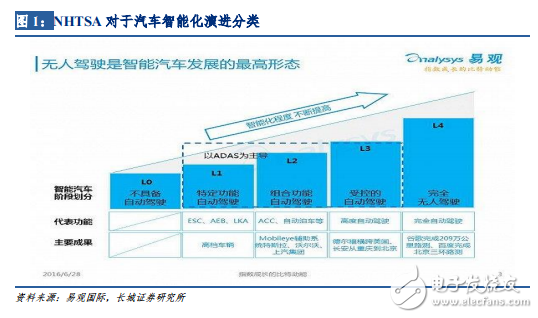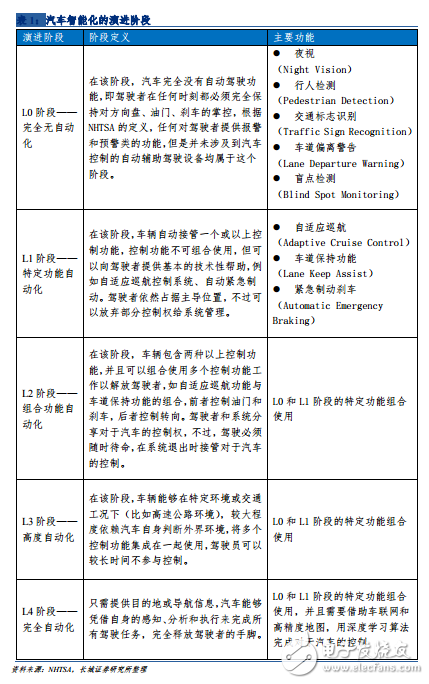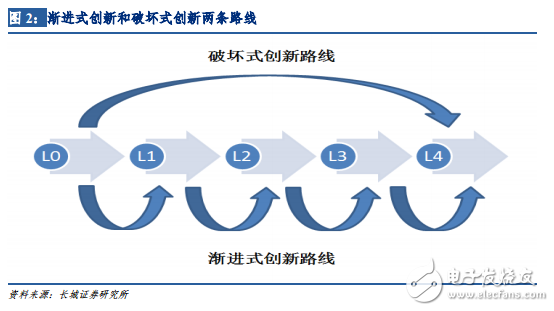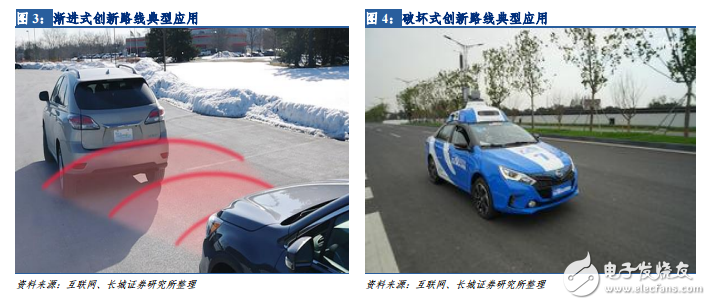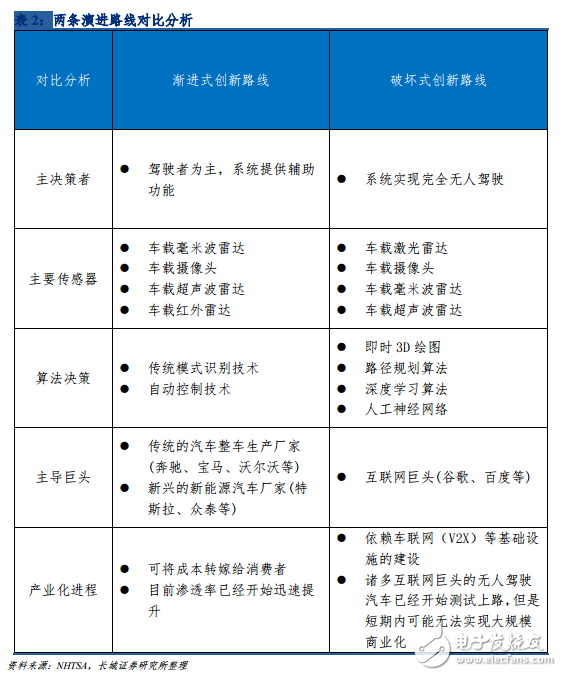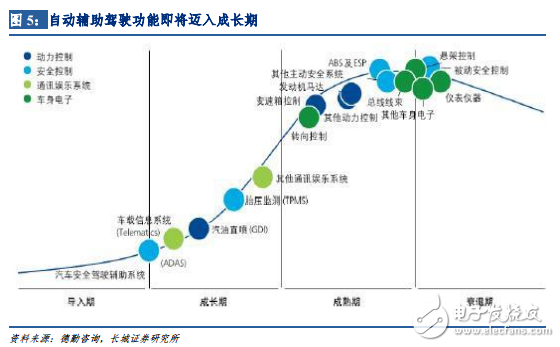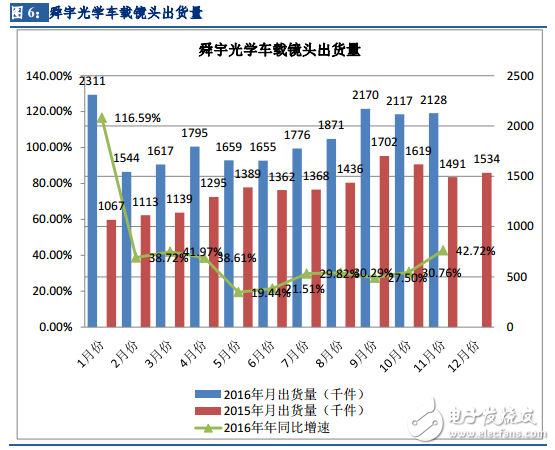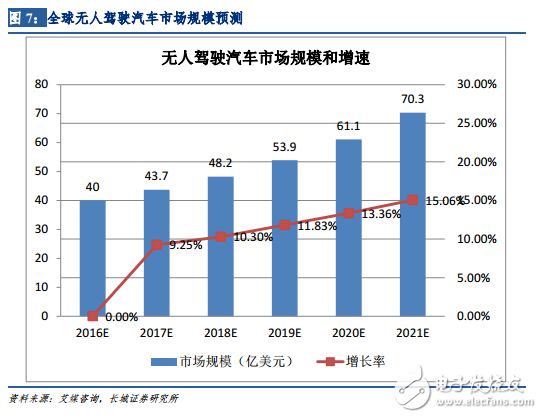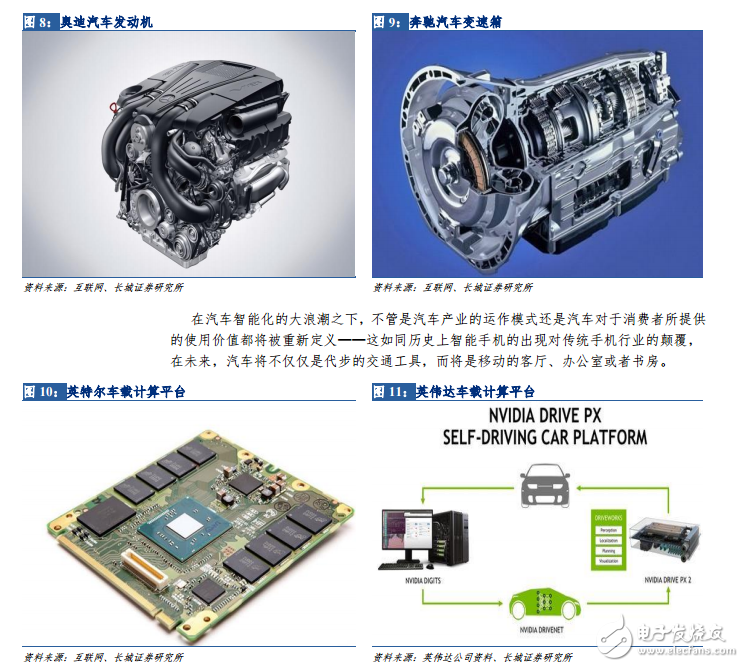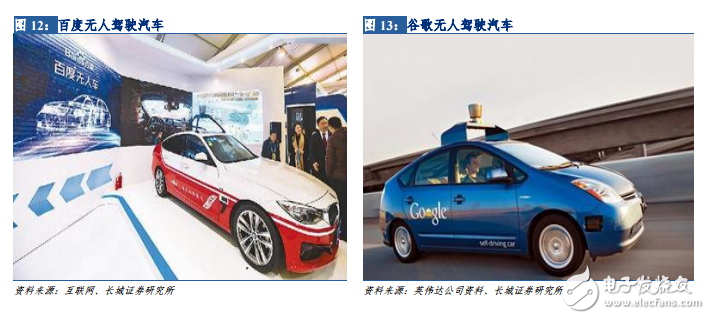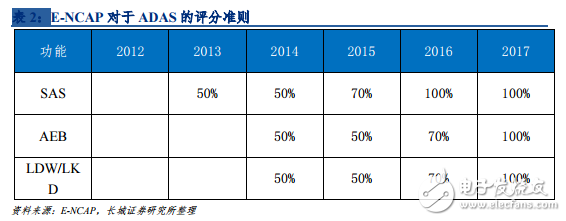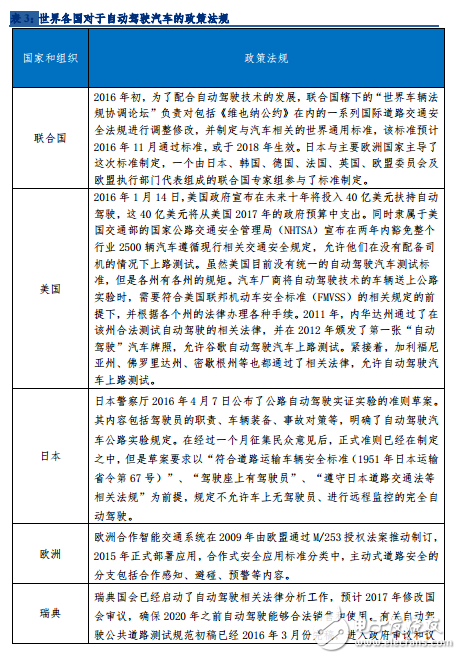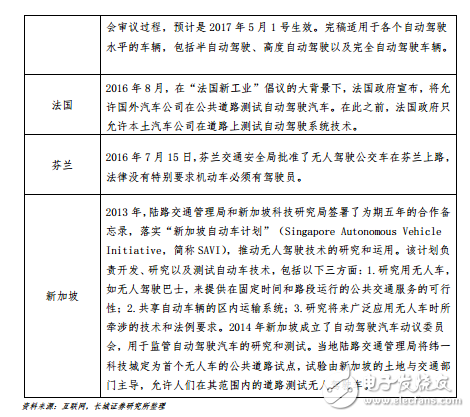In the intelligent evolution of the automobile, analogous humans classify the hardware from the functional layer, the sensing layer is the eye, the processing layer is the brain, and the execution layer is the hand. In the short term, the penetration rate of the automatic assisted driving technology route has begun to increase rapidly. In the long run, the driverless car may be the ultimate form. Analysis of Automobile Intelligentization Based on Automobile Intelligentization——Two Steps of Progressive Innovation and Destructive Innovation: 1. The Evolution Stage of Automobile Intelligentization According to NHTSA's classification of automotive intelligent evolution, the intelligent evolution of automobiles is divided into five stages. ï¬ The L0 phase corresponds to no automation at all, and the driver is completely in control of the steering wheel, throttle and brakes. According to this definition, the driving recorder and the automatic assisted driving function involving only the alarm and warning functions also belong to the L0 phase. ï¬ The L1 phase corresponds to the automation of specific functions. At this stage, the driver takes the dominant control position of the car, but can release certain functions for system management. The vehicle can automatically take over one or several specific control functions, but several control functions cannot be combined. Typical functions are automatic emergency braking and adaptive cruise. ï¬ L2 phase corresponds to the combination of function automation, in which the driver and system share control of the car, the system can achieve more than two control functions, and can combine multiple control functions to release the driver, the typical function is adaptive The combination of cruise function and lane keeping function, but the driver must be on standby to take control of the car when the system exits. ï¬ The L3 phase corresponds to a high degree of automation. At this stage, the system occupies the dominant control position of the vehicle. Under certain environmental or traffic conditions (such as the highway environment), the system depends on the judgment of the external environment. The system can be combined. With multiple control functions, the driver can take control for a longer period of time, but still needs to take over the system when necessary. ï¬ The L4 phase corresponds to full automation, in which the system controls the position of the car completely. The driver only needs to provide the destination or navigation information. The car can complete all driving tasks by its own perception, analysis and execution, and completely release the driving. Hands and feet. 2. Progressive innovation and disruptive innovation We judge that there are two evolutionary routes for automobile intelligence, namely, the progressive innovation evolution route corresponding to automatic assisted driving and the destructive innovation evolution route corresponding to driverless driving. We believe that automatic assisted driving is not equal to driverless driving. The essence of the former is the modular superposition and functional development of the original driving system. The purpose is to provide the driver with a convenient, comfortable and safe driving environment. The main decision maker remains It is a human; the latter is a new type of mobile transport robot capable of autonomous navigation. Its shape design and application are not limited to the existing model, and its main decision maker is artificial intelligence. Our analysis, automatic assisted driving progressive innovation route with millimeter wave radar, infrared radar, ultrasonic radar and vehicle camera as the main sensor, its core technology is automatic control technology and traditional pattern recognition technology, its leading car manufacturers And emerging electric vehicle manufacturers, this technology route can pass the cost to consumers; the unmanned destructive innovation route uses high-precision laser radar as the main sensor, with high-precision map as the reference coordinate system, based on deep learning As the algorithm of decision making, neural network is the 3D real-time mapping and deep learning algorithm. This technology route requires a large amount of infrastructure investment for a long time, and relies heavily on the Internet of Vehicles (V2X). Currently, the Internet networking standard has not been unified, and the infrastructure is missing. It may be difficult to commercialize on a large scale, but this may be the ultimate evolution of driverless cars. According to AutoLab's data, the penetration rate of the automatic assisted driving functions of various functions in the domestic market in October 2015 was: blind spot detection function (BSD) 3.8%, automatic parking entry (AP) 2.6%, forward collision warning (FCW) 2.6%, automatic emergency braking (AEB) 2.4%, panoramic camera (SVC) 2.3%, lane departure warning (LDW) 1.7%, adaptive cruise navigation (ACC) 1.3%, lane keeping assist (LKA) 0.8%. The penetration rate of the automatic assisted driving system in the global vehicle market is also less than 10%, the market in Europe and the United States is close to 8%, and the market in emerging countries is only 2%. The market space is still very huge. According to the estimation of PR Newswire Consulting, the penetration rate of global ADAS will be greatly improved in the future. It is estimated that the global new car ADAS loading rate will reach 50% in 2022. We judge that the automatic assisted driving function is in the transition period from the introduction period to the growth period. Investment opportunities. According to HIS research, global vehicle camera shipments will increase from 28 million in 2014 to 82.7 million in 2020, with a compound annual growth rate of 19.8%. According to data released by Sunny Optical, in 2015, the sales volume of Sunny Optical Automotive Lenses was 16.51 million, and the cumulative shipments in the first 11 months of 2016 reached 20.64 million. The volume of cargo shipments is between 22 million and 23 million. In 2016, the growth rate of vehicle lens shipments was between 33% and 39%. According to the sales of Sunny Optical, its market share in the field of vehicle lenses. It is about 30% to 35%, so it is speculated that the global shipment of the vehicle lens market in 2016 will be between 62.85 million and 76.67 million, which is much higher than the HIS research data. According to Ai Media Consulting Research, the global driverless car market is about 4 billion US dollars in 2016. It is estimated that the global market will reach about 7.03 billion US dollars in 2021, with a compound annual growth rate of 11.8%. The analysts of the agency believe that although Internet giants such as Baidu and Google are all engaged in the field of driverless driving, due to the restrictions of policies and regulations, the immature technology industrialization and the comprehensive consideration of cost, the scale of the driverless car market will change in the short term. Not big, the industry as a whole is in the internal testing stage, it is difficult to achieve large-scale promotion. In summary, in the short-term, the penetration rate of the intelligent assisted driving intelligent evolution route has begun to increase rapidly, but in the long run, the intelligent evolution of driverless vehicles may be the ultimate form. Automobile intelligence is the next inevitable stage of the evolution of the automotive industry Since the birth of the car, engines and gearboxes have always been their most important components, and the overall development of the automotive industry has been driven by both. However, after the 21st century, the automotive industry is increasingly being Information technology has changed, from the very beginning to improve the design, production, manufacturing and other processes of automobiles, and now to change the car itself, the automotive industry is undergoing a profound revolution. We believe that the automotive industry is undergoing a profound transformation. The future trend of intelligence, networking and electrification is making the car look like a computer with four wheels, processor, computing power, internet connection, etc. Digital elements are also replacing the core position of mechanical components such as engines and gearboxes, that is, vehicle chip/computing power providers will be at the heart of the future smart car industry. Under this industrial revolution, the value chain of the automobile industry may be reconstructed. Chip companies such as intelligent software systems and processors may be at the top of the industrial chain, taking most of the profits, and manufacturing and auto parts production. The status of the enterprise may begin to sink, which may be a new opportunity for China's electronics manufacturing industry. 1. Promotion by regulatory agencies and support from government legislation The promotion of regulators and the support of government legislation are a major driving force for driving automotive intelligence. The European New Car Assessment Program (E-NCAP) and The Insurance InsTItute for Highway Safety (IIHS) are the two most authoritative organizations for vehicle crash safety testing. Other countries The region and the region will make a large number of reference and reference to the scoring standards set by the above two organizations when formulating the vehicle collision safety test standards. According to the roadmap published by E-NCAP, since 2013, it has adjusted the scoring rules for new cars and added more assessments of Advanced Driver Assistant Systems (ADAS). By 2017, Speed ​​Assistant System (SAS), Autonomous Emergency Braking (AEB), Lane Departure Warning (LDW/ Lane Keep Assist) The scoring requirement for LKD, which has been abbreviated as LKD, has been set to 100% of the total installed capacity of the car. On March 18, 2016, the US Highway Safety Administration (NaTIonal Highway Traffic Safety AdministraTIon) and IIHS also announced that 20 automakers (GM, Ford, Fiat Chrysler, Toyota, Honda) accounted for more than 99% of the US auto market share. , Nissan, Mazda, Mitsubishi, Fuji Heavy Industries, Hyundai, Kia, Audi, BMW, Daimler, Volkswagen, Porsche, Volvo, Maserati, Jaguar Land Rover, Tesla) have agreed to allow automatic emergency system on September 1, 2022. The move (AEB) became the technical standard, and Toyota stated that all new cars sold in the United States in 2017 must be equipped with the AEB function. Due to the particularity of the automobile as a means of transportation, the road of self-driving or unmanned vehicles will inevitably lead to the difficulty of defining the responsibility of traffic accidents. Therefore, the support of national government legislation and the definition of responsibility by the regulatory agencies are also a major Obstacles, but this obstacle has now gradually disappeared with the support of national government legislation and the details of regulatory policies. The intelligent technology of automobiles has become increasingly mature. On this basis, the supervision of the regulatory agencies has led automakers to spontaneously integrate automatic assisted driving modules into newly developed models, igniting the booming development of the automotive electronics market, blind spot detection (BDS). L0-level functions such as lane departure warning (LDW) have begun to spread in the domestic auto market, and L1 functions such as automatic emergency braking (AEB) and adaptive cruise (ACC) are beginning to sprout; it is also worth noting that with The legislation and regulations of unmanned vehicles have gradually become clear in various countries. The road test of unmanned vehicles and the real commercialization of the future are gradually advancing and landing. 2. Driver's experience improvement Whether it is automatic assisted driving or unmanned driving, there will be a significant improvement in the driver's user experience, which will be another important driver of automotive intelligence. Auto-assisted driving has direct help in reducing illegal driving and enhancing hazard warning and avoidance. The blind spot detection function (BSD) and the lane departure warning (LDW) function can effectively reduce the probability of a car accident. Automatic emergency braking (AEB) can greatly reduce the casualties caused by a car accident. Driverless cars can greatly liberate human hands, allowing artificial intelligence to complete the takeover of driving functions, which can greatly enhance the full use of human time. From the statistics of foreign countries, every driver in Germany has been in traffic jam for a year and a half, which is a huge waste of time for people and economic development. More and more vehicles are now in the first phase of full driverless driving, with some automated driving features. Experience the benefits of automated driving in a real driving environment. If in the near future, the driverless car can be fully realized, human beings will be liberated, have more free time, and allow humans to spend less time to reach their destinations, helping people reduce time wasted on commuting. The intelligentization of the car has greatly improved the driver's user experience. Some studies have shown that China's dependence on the Internet after the 80s and 90s ranks 7th in the world. The characteristics and needs of consumers also determine the development of smart cars. The direction. Chinese consumers' demand for smart cars is mainly in four aspects: safety, convenience, experience and personalization. Consumers have higher requirements for the interactive experience of the fourth screen, such as gesture control, voice control, and head-up display. These interactions will make the operation smoother and improve the driving experience, as consumers demand personalized products. Increased, car manufacturers have also begun to provide consumers with more and more choices.
Innosilicon Asic Miner:Innosilicon A9 ZMaster,Innosilicon A9++ ZMaster,Innosilicon A9+ ZMaster
Innosilicon is a worldwide one-stop provider of high-speed mixed signal IPs and ASIC customization with leading market shares in Asian-Pacific market for 10 consecutive years. Its IP has enabled billions of SoC's to enter mass production, covering nodes from 180nm to 5nm across the world`s foundries including: GlobalFoundries, TSMC, Samsung, SMIC, UMC and others. Backed by its 14 years of technical expertise in developing cutting-edge IPs and ASIC products, Innosilicon has assisted our valued partners including AMD, Microchip and Microsoft to name but a few, in realizing their product goals.
Innosilicon team is fully devoted to providing the world's most advanced IP and ASIC technologies, and has achieved stellar results. In 2018, Innosilicon was the first in the world to reach mass production of the performance-leading GDDR6 interface in our cryptographic GPU product. In 2019, Innosilicon announced the availability of the HDMI v2.1 IP supporting 4K/8K displays as well as our 32Gbps SerDes PHY. In 2020, we launched the INNOLINK Chiplet which allows massive amounts of low-latency data to pass seamlessly between smaller chips as if they were all on the same bus. With a wide range of performance leading IP in multiple FinFET processes and 22nm planar processes all entering mass production, Innosilicon's remarkable innovation capabilities have been proven in fields such as: high-performance computing, high-bandwidth memory, encrypted computing, AI cloud computing, and low-power IoT.
innosilicon zec miner,Innosilicon A9 ZMaster,innosilicon a9 50ksol miner,innosilicon a9 miner,a9 50ksol zmaster Shenzhen YLHM Technology Co., Ltd. , https://www.sggminer.com